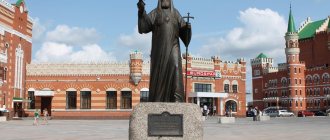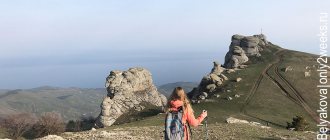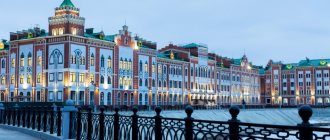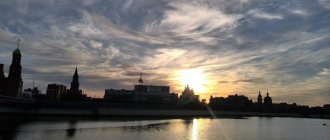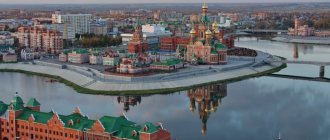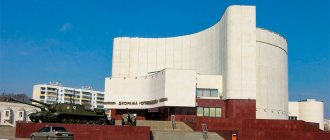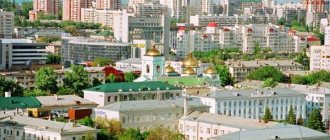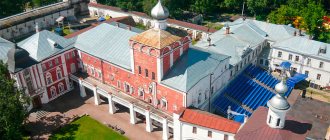What to visit in Yoshkar-Ola for free:
Assumption Street and the Church of the Assumption of the Blessed Virgin Mary
Assumption Street and the Church of the Assumption of the Blessed Virgin Mary
The Church of the Assumption of the Blessed Virgin Mary is located next to the Government House; its construction was timed to coincide with the 60th anniversary of the victory in World War II. The temple was consecrated immediately - on August 28, 2006.
Nearby is the chapel named after St. Nicholas, and the Church of the Assumption itself is decorated with hand-made wall mosaics, an altar and painted icons.
Address: Uspenskaya street, 40, Yoshkar-Ola
Opening hours: daily, Monday – closed; morning service – 8:00, evening – 17:00
Entry: free
Official website: https://uspenie-ola.cerkov.ru/
"Yoshkin cat"
"Yoshkin cat"
Located near the main entrance to the University of Mari. The sculpture was created in 2011 in Kazan, and then transported to Yoshkar-Ola. Interesting fact: the prototype was a cat who lived in the creators’ studio.
During the existence of the sculpture, many legends appeared around it. They say that if you rub a cat's paw, it will bring good luck. In total, there are already as many as 5 sculptures dedicated to cats in the city.
Address: Leninsky Prospekt, Yoshkar-Ola
Opening hours: 24 hours a day
Entry: free
Square of the Republic and the Blessed Virgin Mary
Square of the Republic and the Blessed Virgin Mary
The Square of the Republic and the Blessed Virgin Mary was built in 2007 and received this name for a reason. As planned, this name should symbolize the connection between the Republic of Mari El and the Virgin Mary.
A fountain was installed on the square, which is decorated with sculptures. The sculptures play out the plot of the Feast of the Annunciation, in honor of which the Cathedral of the Blessed Virgin Mary was built.
Address: Republic Square and the Blessed Virgin Mary, Yoshkar-Ola
Opening hours: 24 hours a day
Entry: free
Medici Park
Medici Park
The main element of the park is the sculpture of Lorenzo de' Medici, the height of which reaches 3.5 meters, and it is cast entirely from bronze. It was created in 2012 with money from patrons.
The compact park includes alleys planted with maple trees. The park ensemble was built in the Italian style and is a symbol of the prosperity of the Republic.
Address: Voskresenskaya embankment, Yoshkar-Ola
Opening hours: 24 hours a day
Entry: free
Blagoveshchensky cathedral
Blagoveshchensky cathedral
The temple is the main element of the architectural complex erected on the river embankment, as well as the cathedral of the Mari diocese.
The parish of the Annunciation Cathedral was originally created to attract a new generation and introduce them to the Orthodox faith. It’s worth a visit if only for its impressive size and aesthetic considerations.
Address: Voskresenskaya embankment, 32, Yoshkar-Ola
Opening hours: daily, morning service – 8:00, evening – 17:00
Entry: free
Official website: https://mari.eparhia.ru/churches/eparhii_yoshkar-olinskoi/capital/?ID=5222
Gogol Square
Gogol Square
This is one of the best squares in the city. Oddly enough, it is decorated with a monument to the writer Nikolai Vasilyevich Gogol.
If you walk a little, you will see Gogolevsky Boulevard, which was built quite recently, at the end of 2014, and behind it is the Gogolevsky Bridge, running across the Malaya Kokshaga River.
Address: Gogol street, Yoshkar-Ola
Opening hours: 24 hours a day
Entry: free
Resurrection Cathedral
Resurrection Cathedral
The cathedral was built in 1759; funds from parishioners and the merchant Bulygin were used for the construction. It also hosts water blessing prayers for expectant mothers twice a month.
On the territory of the Resurrection Cathedral there are several chapels, and inside everything is decorated with icons and crosses, in the center there is an altar.
Address: Voznesenskaya street, 45, Yoshkar-Ola
Opening hours: Wednesday - Sunday, morning service - 8:00, Wednesday at 7:30, evening - 16:30
Entry: free
Official website: https://mari.eparhia.ru/churches/eparhii_yoshkar-olinskoi/capital/?ID=5224
YOSHKAR-OLA
YOSHKAR-OLA, a city in Russia, the capital of the Mari El Republic, forms the mountains. district Population 274.7 thousand people. (2019). J.-O. located in the center. parts of the republic, on the river. Malaya Kokshaga (left tributary of the Volga). Railway station. Road junction. Airport.
Story
Yoshkar-Ola. Church of Our Lady of Three Hands in the former home of I. A. Pchelin. 18th century
Founded in 1584 by decree of Tsar Fyodor Ivanovich as the “Tsarev City” fortress on the lands of the Cheremis (Mari) annexed to the Russian state. To distinguish it from other cities with the same name, they began to write it as “Tsarev city on Kokshaga” or “Tsarev Kokshaisky”, in the end. 16 – beginning 17th centuries The names Kokshazhsk, Kokshats(zhs)ky town were also used, in the 1st half. 17th century the name was assigned to the city. Tsarevokokshaysk. It was subordinate to the Order of the Kazan Palace and had important defensive significance. Residents of the city (streltsy and Cossacks) served as border guards and also collected tribute (yasak) from the local Mari population. In the 17th century gradually lost its military significance, the main occupation of the population became agriculture (including the cultivation and processing of hops), as well as trades (fur, logging, distilling) and trade. In 1708–1920, a district town in the Kazan province (in 1781–96 – Kazan governorship). From the beginning 18th century The Alexander-Elizabeth Fair was held here, and merchant dynasties formed (Ganeshevs, Talantsevs, Bulygins, Pchelins). In addition to the Russian population (mainly immigrants from the central provinces of the Russian Empire), the so-called. newly baptized (Mari and Mordovians who converted to Orthodoxy).
Yoshkar-Ola. Cathedral Mosque. Con. 1990s
From the 2nd third of the 19th century. Tsarevokokshaisk is a place of political exile (participants of the Polish uprising of 1863–64 were exiled here, in particular). After the October Revolution of 1917, Soviet power was established peacefully in the city. 17.2.1919 renamed Krasnokokshaysk. From June 18 to November 25, 1920 it was part of the Vyatka province. In 1920–36 the center of the Mari Autonomous Okrug (at the same time in 1920–21 the center of the county, in 1921–31 the center of the canton). In 1927 the city was connected by the Moscow-Kazan railway line. from the village Zeleny Dol (now Zelenodolsk). 25.1.1928 renamed J.-O. (Mar. – “Red City”). In 1936–90 the capital of the Mari Autonomous Soviet Socialist Republic, in 1990–92 – the Mari SSR, from 1992 – the Republic of Mari El. Since 1931 it has been a city of regional (since 1936 republican) significance. In 1941, during the Great Patriotic War, in J.-O. The equipment of industrial enterprises was evacuated, which became the basis of modern large factories: Mari machine-building, commercial engineering (now Mariholodmash), semiconductor devices. In 1953, part of the railway was built. line Yoshkar-Ola - Yaransk, in 1976 a permanent railway was opened. communication along the Yoshkar-Ola - Yaransk line of the Gorky Railway. In 1990–2010 it had the status of a historical city of Russia. Since 2005, the center of the mountains. districts.
Architecture
Preserved: Ascension Cathedral (1756; closed in 1937, returned to the Russian Orthodox Church in 1992, active since 1995) and Ch. the house of the estate of the merchant I. A. Pchelin (18th century), the stone building of the New Epiphany school (1749) at the Trinity Church. (1736), Tikhvinskaya c. (1774); ancient houses - stone and wooden, with carved platbands, cornices, porches and gates. The general plan for the development of the city was approved in 1835. Of the buildings of the con. 19 – beginning 20th centuries preserved: the house of I.V. Chulkov, the houses of industrialists Naumov and Bulygin. In 1937, the House of Soviets was built in the forms of late constructivism (architect A. Z. Grinberg, engineer P. S. Shorin; now Mar. State University and other institutions). According to the general plan of 1948, buildings were erected in the neoclassical style (National Drama Theater named after M. Shketan, architect M. F. Ni, engineer P. A. Samsonov; former Sovetskaya Hotel, architect I. I. Vinogradov; both 1960), residential buildings with brightly colored details and colorful ornaments; later – Government House, city building. administration. Cathedral Mosque (late 1990s). In the 2000s. Major construction projects are underway under the Capital program. work. Built: Ice Palace, Assumption Church (both 2006), Chapel of St. Nicholas (2007), etc. Monuments: V.I. Lenin (1966, sculptor M.G. Manizer, architect I.E. Rozhin), the first governor of the city, Prince. I. A. Obolensky-Nogotkov (2007, sculptor A. N. Kovalchuk).
Centers of science and culture
Among scientific institutions – Mar. Research Institute of Language, Literature and History named after. V. M. Vasilyeva, Mar. Institute of Education. State universities: Mar. technical University (its history dates back to the Forestry Faculty of Kazan University, since 1922 in Y.-O.; the name and status have changed several times, the current name has been since 1995), Mar. pedagogical Institute named after N.K. Krupskaya (1931), Mar. University (1972). Among the non-state universities are the Interregional Open Social Institute (2003), the Institute of International. trade and law. Moscow branches and Kazan universities. National fuck them. S. G. Chavaina (founded in 1876, opened in 1877; current name and status since 1922). National Museum of the Republic of Mari El named after. T. Evseeva (1920), Republican Museum of Fine Arts (1981; building - 1980, architect V. I. Babenko), House-Museum of the writer N. S. Mukhin (1990), Museum of the History of Yoshkar-Ola (1996), Museum folk applied art (1999), House-Museum comp. I. S. Klyuchnikova-Palantaya (1960). National Drama Theater named after M. Shketana (1919), Rus. Drama Theater named after G. Konstantinova (1937), Republican Puppet Theater (1942), Mari Opera and Ballet Theater, Youth Theater (1991). State Philharmonic Society (1939; now named after Y. Eshpai). State choir chapel (1981; now named after A.I. Iskandarov). Ensemble of folk instruments “Mari Kundem” (1984).
International festivals: Russian theaters of the republics of Russia and foreign countries (annually), theaters of the Finno-Ugric peoples “Mayatul” (once every 2 years), opera and ballet theater “Winter Evenings” (since 1996, annually); All-Russian festival-competition russian romance "White Acacia" (since 2003), art festival "Mari Autumn" (annually), festival in honor of Galina Ulanova.
Sport
The Druzhba football club (founded in 1962) plays its matches at the stadium of the same name (built in 1961; seats 12.5 thousand spectators). Ice Sports Palace "Mari El" for 2.5 thousand seats.
Farm
Among the leading enterprises of the city, machine-building industries predominate. Mari Machine-Building Plant (1941) is the largest republican enterprise of the military-industrial complex, part of the Almaz-Antey concern; produces air defense equipment (including anti-aircraft missile systems), as well as equipment for the agro-industrial complex, woodworking machines, electrical products, etc. “Special Design and Technology Bureau “Crystal”” (1970) produces products from metal powders for the automotive industry industry, agricultural engineering, railways transport, electrical engineering; pumps for the chemical industry and ultrasonic cleaning equipment, - forestry equipment, production association "Inreko" - tools for metalworking. Contact (1964; also produces resistors and automotive electronics) also specialize in the production of commercial refrigeration equipment. The production of electrical engineering and instrumentation has been developed: "Rodina Association" (1991; electrical products, electronic components for the automotive industry), "Nata-Info" (1989; LED equipment), "Semiconductor Devices Plant" (1941; metal-ceramic cases for special purposes for integrated microcircuits and semiconductor devices), SKB "Khromatek" (1991; gas chromatographs and gas chromatography-mass spectrometers, equipment for gas purification and analysis of oil and petroleum products). Chemical industry enterprises play an important role in the city’s economy: “Artificial Leather Plant” (a large Russian manufacturer of artificial leather, awning and film materials) and “Marbiopharm” (1942; medicines, biologically active and food additives, substances, etc.), scientific -production company "Genix" (liquid detergents and disinfectants. J.-O. also produces steel doors (Intekron, metal structures "Vybor", "Portal"), furniture (furniture factories "Elf", "Mari" furniture 12", "M Dorf"), building materials ("Balaton Group" - building metal structures; "Stroykeramika" - ceramic brick); there are light goods enterprises (Yoshkar-Olinskaya shoe factory, Yoshkar-Olinskaya hosiery factory "Maritex") and food [ plant for the production of frozen bakery semi-finished products "Rus-Bakery", Yoshkar-Olinsky meat processing plant, Yoshkar-Olinsky confectionery factory (1944; since 2003 as part of the United Confectioners holding)] industry; The thermal power plant is operating.
50 km north of the city is the Mari Oil Refinery (one of the largest enterprises in the Republic of Mari El; capacity is 1,250 thousand tons of oil per year).
Neighborhood
Near J.-O., in the village. Ezhovo, - female Myronositsky [in honor of the Myrrh-Bearing (Tsarevokokshayskaya) Icon of the Mother of God] mon. [founded in the 17th century. as men's, closed in 1924, revived in 1993–94; preserved: c. Holy Myrrh-Bearing Women with a tented bell tower (both 1710s), fraternal building, 18th century, etc.].
Where to go in Yoshkar-Ola and what else to see:
Botanical Garden-Institute of Perm State Technical University
Botanical Garden-Institute of Perm State Technical University
The area of the botanical garden is almost 74 hectares, and all exhibitions are located in the very center and surrounded by a protective zone.
This place contains many specimens of flora from all over the world; the garden’s funds contain almost 6,000 plant specimens. Various scientific studies are carried out on the basis of the obtained samples.
Address: Mira street, 2B, Yoshkar-Ola
Opening hours: Monday – Friday from 8:00 to 17:00
Entrance: 1200 rubles – excursion for a group of up to 6 people
Official website: https://botsad.volgatech.net/
National Museum of the Republic of Mari El
National Museum of the Republic of Mari El
The National Museum has collected many exhibitions dedicated to the Mari, their culture and history. The historical complex was founded in 1920.
At the moment, the Museum of the Republic of Mari El is located in a place built in 1903. Having undergone many restorations, the building has still not lost its flavor.
Address: Sovetskaya street, 153, Yoshkar-Ola
Opening hours: daily from 10:00 to 18:00; Monday - closed
Entrance: 150 rubles – adult ticket, 90 rubles – schoolchildren, pensioners, students, 70 rubles – preschoolers
Official website: https://www.fumus.ru/
Museum of the History of the City of Yoshkar-Ola
Museum of the History of the City of Yoshkar-Ola
The richest and most interesting exhibitions of the museum have been operating since 1996 on the initiative of the city administration to inform residents about the history of their native city.
The exhibition includes more than 17,000 items and is still constantly being updated. The exhibition is dedicated to the fate of Yoshkar-Ola in the 16th–20th centuries. In 2005, the Department of Military Glory was opened.
Address: Voznesenskaya street, 39, Yoshkar-Ola
Opening hours: main building: Tuesday - Friday from 10:00 to 18:00, Saturday - Sunday from 10:00 to 16:00; Monday is a day off. Department of Military Glory: Monday – Friday from 8:00 to 17:00; Saturday – Sunday – closed
Entrance: 80 rubles – adult ticket, 50 rubles – pensioners, students, schoolchildren. Excursions: group – from 70 to 100 rubles; individual – 500 rubles
Official website: https://www.i-ola-museum.ru
Mari Drama Theater
Mari Drama Theater
The Mari Theater opened its doors for the first time in 1919. At that moment, it was a simple mobile theater in which students of a rural school performed.
Now the Mari National Theater named after M. Shketan is one of the oldest drama theaters in the republic and a center for the cultural development of the population.
Address: Lenin Square, 2, Yoshkar-Ola
Opening hours: daily from 11:00 to 19:00; Monday - closed
Entrance: price depends on the performance
Official website: https://shketan.ru
Mari Opera and Ballet Theater
Mari Opera and Ballet Theater
The Erik Sapaev Theater appeared in 1968 and took place in the same building as the Mari Drama Theater. They wanted to unite them, but after the arrival of Konstantin Ivanov in 1999, everything changed for the better.
Now the theater management organizes festivals and invites young artists and directors to conventions.
Address: Komsomolskaya street, 130, Yoshkar-Ola
Opening hours: daily, on weekdays from 11:30 to 18:30, on weekends from 11:00 to 16:00
Admission: price depends on performance
Official website: https://www.operaballet.net
Ferris wheel
Ferris wheel
It is located in the central park of culture and recreation, next to other equally interesting attractions, but of all the types of entertainment, the wheel seems the most impressive from the outside.
If you want to see the beauty of Yoshkar-Ola from a bird's eye view, then you definitely need to visit this place and get a lot of positive emotions.
Address: Komsomolskaya street, 124, Yoshkar-Ola
Opening hours: daily, from 10:00 to 20:00
Entrance: 100 rubles, children under 4 years old – free
Official website: https://park-ola.mari-el.muzkult.ru
Republican Puppet Theater
The Puppet Theater, located on Patriarchal Square, is one of the sources of cultural education for the population. In 2014, it was decided to change the building, and now it resembles a German palace.
Inside there are several auditoriums, a foyer and a local museum. Currently, the theater organizes excursions that include visits to the museum and backstage.
Address: Tsargradsky prospect, 35, Yoshkar-Ola
Opening hours: Wednesday – Friday from 11:30 to 18:00; Saturday – Sunday from 9:00 to 15:00; Monday – Tuesday – closed
Entrance: from 180 to 400 rubles
Official website: https://teatrkukolmariel.ru/main
National Gallery of Art
National Gallery of Art
The gallery was founded in 2007 as a branch of the Museum of Fine Arts. The permanent exhibition consists of paintings by Mari artists, and temporary exhibitions include completely different exhibits.
Private collections, paintings from other world and Russian museums - all this attracts many art connoisseurs visiting the gallery.
Address: Leninsky Prospekt, 24, Yoshkar-Ola
Opening hours: Tuesday – Saturday from 10:00 to 18:00
Entrance: permanent exhibition: 80 rubles – adult ticket, 50 rubles – discounted ticket
Official website: https://www.museum.ru/M1529
Gulag Museum
Gulag Museum
The museum is located in a house that once belonged to a merchant, and during the USSR, people who issued arrest orders were located there.
The museum is very popular among history buffs and simply those who are not indifferent to the past of their people. Many photographs, papers and other reminders will remind you of what once happened in the USSR.
Address: Voznesenskaya street, 39, Yoshkar-Ola
Opening hours: Monday – Friday from 11:00 to 19:00
Entrance: 100 rubles – adult ticket, 50 rubles – schoolchildren, pensioners, students
Museum of Folk Applied Arts
Museum of Folk Applied Arts
The museum was created in 1999 in the mansion of the zemstvo contractors; after the revolution, the building changed its purpose many times.
The Museum of Folk and Applied Arts organizes excursions for different age groups and conducts master classes, teaching new things, so here everyone will find something to their liking.
Address: Chernyshevsky street, 23, Yoshkar-Ola
Opening hours: daily, from 10:00 to 18:00; Monday - closed
Entrance: 40 rubles – adult ticket, 20 rubles – schoolchildren, pensioners, students. Photography – 50 rubles, video filming – 100 rubles
Official website: https://www.fumus.ru
Russian Drama Theater
Russian Drama Theater
The theater is named after Georgy Konstantinov, who held the management of the theater in his hands for 30 years (1964 - 1994).
Nowadays the drama theater hosts a lot of different performances for people of all ages. Various festivals are also organized on behalf of the theater - this is a huge contribution to the development of the culture of Mari El.
Address: Nikonova Square, 1, Yoshkar-Ola
Opening hours: daily from 11:00 to 18:00
Entrance: from 200 to 950 rubles
Official website: https://rusdramtheatre.ru
Annunciation Tower
Annunciation Tower
This is a relatively young monument, built in 2007, but even in such a short period of time it managed to become a symbol of Yoshkar-Ola.
Its main attraction is the clock, which follows the shape of the Spasskaya Tower chimes. The time on the clock is adjusted by the satellite signal. The tower is also a favorite backdrop for photographs among tourists.
Address: Republic Square and the Blessed Virgin Mary, 1, Yoshkar-Ola
Opening hours: daily from 10:00 to 18:00; Monday - closed
Entrance: 100 rubles
Clock "12 Apostles"
Clock "12 Apostles"
Amazing design. Bronze statues perform the famous story from the Gospel - “The Entry of the Lord into Jerusalem”, appearing every 3 hours and delighting the people who have gathered to watch it.
A special system of mechanisms, designed to last 30 years, powers the figures. And this moving sculptural composition was assembled in just a year!
Address: Tsargradsky prospect, 37, Yoshkar-Ola
Opening hours: daily from 9:00 to 18:00 every 3 hours; excursion to the tower: daily from 9:15 to 20:15 every hour
Entrance: free; excursion to the tower: 200 rubles – adult ticket, 100 rubles – children’s ticket
Part 2. Architectural.
In addition to the “Embankment of Bruges”, Yoshkar-Ola still has something to boast about. Take, for example, the cultural and historical complex “Tsarevokokshay Kremlin”, built in 2009 according to all the canons of a fortification structure of the 14th-15th centuries, the only thing missing is embankments and a deep ditch:
(The photo is not mine, it was found on the Internet, I just didn’t have a good quality photo in my reserves)
On the territory of the Kremlin (by the way, the youngest in Russia) there is an exhibition of artillery pieces, as well as stands with the history of the Mari land and a small chapel.
In addition to the Kremlin, there are unique fortress walls on the right bank of the Kokshaga River, behind them are “hidden”: the recently built Cathedral of the Resurrection of Christ, several government buildings and residential buildings, all of this together creates a beautiful picture, not inferior in beauty to the Bruges embankment located opposite:
The same thing, but a little closer and from a different angle:
On Patriarchal Square, which is located on the left bank of the river, in addition to the monuments to Alexy II and Peter and Fevronia, which I already talked about above, you can see two unusual buildings: this is the “12 Apostles” complex, similar to a fairy-tale palace, which includes a restaurant, supermarket and television and radio company:
The photo is not mine either. The same problem: there is no high-quality photograph of this building, taken from this site
and the Republican Puppet Theater, stylized as a medieval castle, not yet completed:
The “12 Apostles” complex, in addition to its appearance, is also interesting because of the performance that takes place every three hours, repeating the well-known gospel story - the Entry of the Lord into Jerusalem. To the accompaniment of music, 12 apostles led by Jesus appear from the tower, walk along the balcony and hide in another tower. A fascinating and exciting spectacle.
A similar mechanical system operates in another building - the Italian-style National Art Gallery, which is located on the square. Obolensky-Nogotkov, next to the monument to the governor:
Every hour, accompanied by church hymns, a plot is played out around the central clock telling about the salvation of the “Three-Handed” Icon of the Mother of God during the Turkish invasion of Serbia. An image of the Mother of God appears in the upper left corner of the clock, then a donkey with her image appears from the lower left gate, symbolizing the miraculous salvation of the icon and the coming of the Mother of God. The donkey enters the right gate, it closes, after which the blessing image of the Queen of Heaven appears above it again.
Another attraction of Yoshkar-Ola is the Annunciation Tower, which is a smaller copy of one of the towers of the country’s main Kremlin. The chimes, like the original, chime every hour.
In the next photo, in front of the tower you can see one of the largest fountains in the city - the Archangel Gabriel fountain, trimmed with green malachite stone:
Next to the Annunciation Tower is the Arkhangelskaya Sloboda - a small pedestrian area built up with Italian-style mansions, in which there are service offices for a number of banks and government services.
At Arkhangelskaya Sloboda, I will finish the story about the main attractions of Yoshkar-Ola, however, once in this city, you can discover many interesting and beautiful places that are not described in this review. Be sure to visit the newly built Cathedral of the Annunciation of the Blessed Virgin Mary, stroll along Assumption Street and the flower-filled Chavaina Boulevard, sit in the quiet and cozy park of the government building.
Sights of Yoshkar-Ola in one day:
Obolensky-Nogotkov Square
Obolensky-Nogotkov Square
The first thing that catches your eye when you get to the square is the 6-meter monument to Ivan Obolensky-Nogotkov, who made a significant contribution to the development of the city. In honor of him, oddly enough, such a name was given.
Also on the square is an art gallery, a sculpture of the martyr Bishop Leonidas and a double of the Moscow Tsar Cannon.
Address: Obolensky-Nogotkov Square, Yoshkar-Ola
Opening hours: 24 hours a day
Entry: free
Chavaina Boulevard
Chavaina Boulevard
The main avenue of Yoshkar-Ola and it has this name in honor of the founder of the national literature of Mari El - Sergei Chavain.
On the territory of the boulevard there is a lot of greenery, benches, souvenir shops, cafes and restaurants, and if you decide to take a walk at night, you will also see fountains shimmering with light.
Address: Chavaina Boulevard, Yoshkar-Ola
Opening hours: 24 hours a day
Entry: free
Patriarchal Square
Patriarchal Square
A large square in the city center, it is also called the heart of Yoshkar-Ola. Having appeared not so long ago, it has already managed to captivate many city residents and tourists.
During your visit, you will learn many facts about both the square itself and the attractions located on it, and you will also have a great time enjoying the architecture.
Address: Patriarchal Square, Yoshkar-Ola
Opening hours: 24 hours a day
Entry: free
Bruges waterfront
Bruges waterfront
Houses in the Flemish style, the sound of water, wonderful views, as well as a monument to Empress Elizabeth Petrovna - all this is on the Bruges embankment. Walking along it is wonderful in any weather.
Locals consider the route along the Malaya Kokshaga River one of the best for relaxing in the city and a good walk.
Address: Bruges embankment, Yoshkar-Ola
Opening hours: daily
Entry: free
Well, now some interesting facts about the capital of the Republic of Mari El:
- Fans of the Tula Arsenal should know that the team's goalkeeper and playing coach Alexander Filimonov was born in Yoshkar-Ola and began his football career in the local Spartak (I wonder if a monument dedicated to the famous football player will ever appear in the city and if so, what it will look like ).
- In Yoshkar-Ola, as throughout the republic, bilingualism is in use; in addition to Russian, the Mari language is used to write words, using the Cyrillic alphabet, supplemented by several specific sounds. Therefore, some signs look amazing - seemingly familiar and familiar letters form incomprehensible words, for example: Yolchiem - shoes. Yapok kachkysh - Japanese cuisine. Kevyt – shop. Urem - Street. Bus station - bus station
- Part of the population of the republic has not yet converted to Christianity, and professes a traditional religion; in general, the Mari, especially in the villages, are a very superstitious people, among whom sorcerers and shamans have a truly great influence (and this is in the 21st century)!
- The population of Yoshkar-Ola is about 258,000 people, approximately the same number live in Zarechye and Proletarsky district of Tula
- Prices in the city are at the same level as in Tula or even slightly lower.
- The best time to visit Yoshkar-Ola is July; it is not yet warm in June, and in August it is no longer warm. Winters are long and very snowy, with severe frosts.
By the way, would you like to share your “travel stories”? Write to [email protected] And long live our common endless and cheerful “Gulbari”!

FAQ
Where can you go with children in Yoshkar-Ola? Fountain “Into Space”, Central Park of Culture and Leisure, Replica of the Tsar Cannon, Medici Park, Ferris Wheel.
What can you see in Yoshkar-Ola on your own? Church of the Holy Trinity, Square of the House of Government of the Republic of Mari El, Assumption Street and Church of the Assumption of the Blessed Virgin Mary, Annunciation Cathedral.
4 main attractions of Yoshkar-Ola that are definitely worth a visit? Tsarevokokshay Kremlin, Arkhangelskaya Sloboda, Voskresenskaya Embankment, “12 Apostles” Clock.
Beautiful places in Yoshkar-Ola that are worth visiting
In Yoshkar-Ola there are several outstanding cultural and educational centers where tourists can have an interesting time. The city has interesting places for travelers: museums of art, national culture, art exhibitions are held here, and art galleries are open. The theaters show famous modern and classical productions. Art museums and galleries are exactly what the Red City is famous for.
Yoshkin cat
The main attraction of the city for young tourists. A monument to a character from colloquial folklore - an ironic sculpture depicting a cat imposingly sitting on a bench.
Address: Lenin Square. At Arkhangelskaya Sloboda, 7, there is another thematic sculpture – Yoshkina’s cat next to the cat.
Stop – “Teatralnaya”, bus 5.
Get directions
Best hotels in Yoshkar-Ola
Related materials:
- 36 Izmir attractions recommended for…
- 29 best attractions in Orel,…
- 24 must-see attractions in Cappadocia
- 43 attractions of Adler that are worth seeing
- 33 attractions of Bakhchisaray that are worth visiting
- 41 attractions in Crete that are worth visiting
- 40 attractions in Limassol that are worth seeing
- 43 best attractions in Minsk,…
- 24 best attractions in Vladikavkaz,…
Did you like the article? Share with friends:
